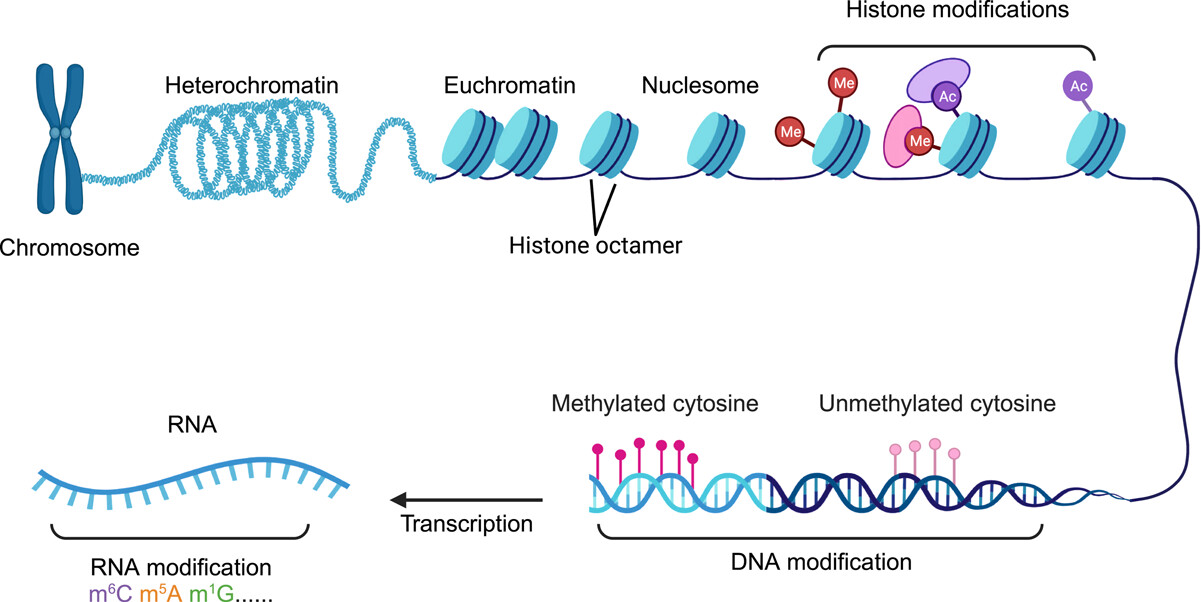MedComm-Oncology | Epigenetic regulation in cancer therapy: From mechanisms to clinical advances

Open the phone and scan
 Regulation of epigenetic modifications on chromatin. Chromatin can be classified according to the local structure of the basic repeating unit, the nucleosome, which is made of DNA and histones. Chromatin can exist in a tightly compacted state called heterochromatin, which is less accessible and silent during transcription, or in a more open state called euchromatin, which is often associated with actively transcribed genes. Each nucleosome comprises DNA wrapped tightly around a histone octamer composed of two H2A, two H2B, two H3, and two H4 subunits. The amino termini of histones, known as histone tails, undergo diverse posttranslational modifications (e.g., acetylation, methylation) as shown in this illustration. Additionally, nucleic acids such as DNA and RNA could also be covalently modified, for example, by adding methyl groups to cytosine residues. This figure was created with BioRender.com.
Regulation of epigenetic modifications on chromatin. Chromatin can be classified according to the local structure of the basic repeating unit, the nucleosome, which is made of DNA and histones. Chromatin can exist in a tightly compacted state called heterochromatin, which is less accessible and silent during transcription, or in a more open state called euchromatin, which is often associated with actively transcribed genes. Each nucleosome comprises DNA wrapped tightly around a histone octamer composed of two H2A, two H2B, two H3, and two H4 subunits. The amino termini of histones, known as histone tails, undergo diverse posttranslational modifications (e.g., acetylation, methylation) as shown in this illustration. Additionally, nucleic acids such as DNA and RNA could also be covalently modified, for example, by adding methyl groups to cytosine residues. This figure was created with BioRender.com.
Epigenetic regulation refers to the alteration of gene expression independent of changes in DNA sequence. It involves chemical modifications such as DNA methylation, histone methylation, and histone acetylation, which are regulated by a coordinated interplay of various regulators to ensure precise spatial and temporal regulation of gene expression. Epigenetic aberrations are commonly observed in cancer and are considered as hallmarks of cancer. In recent years, small molecules targeting specific epigenetic regulators have been developed and are demonstrating promising therapeutic potential in preclinical and clinical trials for cancer treatment. In this review, we summarize the essential regulatory mechanisms and dysfunctions of epigenetic regulators involved in DNA methylation, histone methylation, and histone acetylation during tumor development and progression. Moreover, we discuss the current advances and challenges in cancer epigenetic therapy that target these mechanisms in both hematologic malignancies and solid tumors. Finally, we discuss the potential of combining epigenetic drugs with other therapies, including chemotherapy, radiotherapy, targeted therapy, and immunotherapy, as a promising approach for cancer treatment. Overall, we aim to enhance the understanding of epigenetic regulation in cancer therapy and explore targeted therapeutic strategies based on these mechanisms, to ultimately advance cancer therapy and improve patient prognosis.
Article Access: https://doi.org/10.1002/mog2.59
More about MedComm-Oncology: https://onlinelibrary.wiley.com/journal/27696448
Looking forward to your contributions.


